Note: This article is part of a three-part series on the evolution of cosmology, dark energy and the Hubble tension.
Blowing Up the Universe
The Accelerating Pace of Science and Spacetime
The Universe—with millions upon billions of stars, planets and galaxies—is expanding.
And that expansion is accelerating.
Roll the clock backwards,
and lo and behold! The universe started with a “big bang”.
 |
| A diagram showcasing the evolution and expansion of the universe, starting from the inflationary epoch to the present day Credit: NASA |
These assertions hardly seem
surprising today- nearly every individual with an even passing familiarity with
the developments of science in the past century will recognize these statements
as being true. To live in a dynamic universe that expands and accelerates and
had a beginning (and possibly an end) seems almost intuitive in the modern era,
given our modern sensibilities and the fast pace of change. Our familiarity
with this fact does not echo the familiarity of the scientists of old,
however—for the certainty that we have today regarding the nature of the
universe took centuries of careful thought, observation and experimentation to
establish.
Long before Hubble
pointed the 100-inch Hooker telescope at Mount Wilson Observatory to the skies
between 1922-23, and changed the view of the universe forever--blowing it up by
nearly 8 orders of magnitude and further asserting that it is expanding--the
prevailing scientific view had been one of a static, eternal universe that had
existed for all time and would continue to exist for all time forevermore.
Moreover, the universe was considered to be either infinitely large and
extending in all directions, or only as big as the milky way galaxy. There was
no in-between.
 |
Edwin Hubble using the 100 inch Hooker telescope at the Mount Wilson Observatory in California Credit: Huntington Library, San Marino, Calif. |
These ideas about the
nature of the universe were not established by observation or experiment, but
were accepted almost as axioms, for they seemed to be baked into Newton’s laws.
According to Newton, space was the stage in which events unfolded, and one
could imagine the rhythmic ticking of a massive grandfather clock in the
background recording the passage of time—the same for all observers—ticking
away forever.
This view of space and
time would soon be shattered by a young Swiss patent office clerk named Albert
Einstein, who in his special and general theories of telativity highlighted the
inextricable connection between space and time. Indeed, space is less like an
inert stage and more like a fabric that can be contorted, twisted and even
punctured, and it is this “curvature of spacetime” that provided a truly
satisfactory explanation of the origins of gravity. Time isn’t a separate
entity distinct from space either—it flows at different rates for different
observers depending on their state of motion, and their presence in a uniform
gravitational “well” in spacetime. All of these developments shattered the old
sensical notions of space and time, and ushered in the era of modern physics
and the kind of sci-fi ideas we know and love today. One might argue that it
was these very developments that replaced the old Newtonian view of a clockwork
universe with a chaotic, exotic and fascinating universe that didn’t always
conform to our expectations. But I digress.
Einstein was an
out-of-the-box thinker. After all, the Special Theory and the General Theory
are anything but intuitive. However, Einstein did subscribe to another
conventional view of the time—one of a static and unchanging universe.
So, when the field
equations of general relativity pointed to a universe where gravity would cause
a universe that was initially non-expanding to contract, Einstein modified his
equations by adding a cosmological constant Λ to the equations in 1917, so that
they would describe a static universe. The value of this constant was adjusted
to describe the universe we exist in today.
It's not that Einstein’s
equations wouldn’t work without the addition of this parameter-- in 1922, the
Russian physicist Alexander Friedmann mathematically showed that Einstein's
equations (whatever Λ) remain valid in a dynamic universe. These more general
solutions to Einstein’s field equations were known as cosmological solutions,
and described a universe that could either expand or contract. Einstein’s
“static universe” kept a delicate balance, and was extremely susceptible to
tiny perturbations in spacetime, that could cause the universe to either expand
or contract.
| Yeah, I understand about as much as you do. Remember, I'm not a masters student! Credit: Space.com Forums |
In fact, without the
addition of this extra term to his equations, Einstein may have discovered the
expansion of the universe that Hubble would empirically observe in 1929.
Einstein considered this
move “his greatest blunder”, believing that he should have trusted his original
equations which predicted a repulsive force causing the expansion of spacetime.
As we know, the empirical
observations of Vesto Slipher in 1912, and more famously Edwin Hubble in
1922-1923 showed that the universe was expanding. Less well known is the fact
that they also showed that the universe didn’t just consist of the Milky Way,
but a whole universe of galaxies apart from our own that are moving away from
us faster the farther they are.
This was a brief history
of the developments in science at the beginning of the 20th century.
Let’s take a step back now-- how did Hubble deduce the accelerating expansion
of the universe?
The End of Shapley’s
Universe and the Story of Expanding Spacetime
The answer? Cepheid variables.
A Cepheid variable is
what is referred to as a “standard candle”. It is a pulsing star that varies in
luminosity, discovered by Henrietta Swan Leavitt, an American astronomer and
human computer一 one of the great unsung heroines of science. She discovered a
relationship between the period of pulsing Cepheid variables and their
luminosity—a relation now referred to as Leavitt’s law.
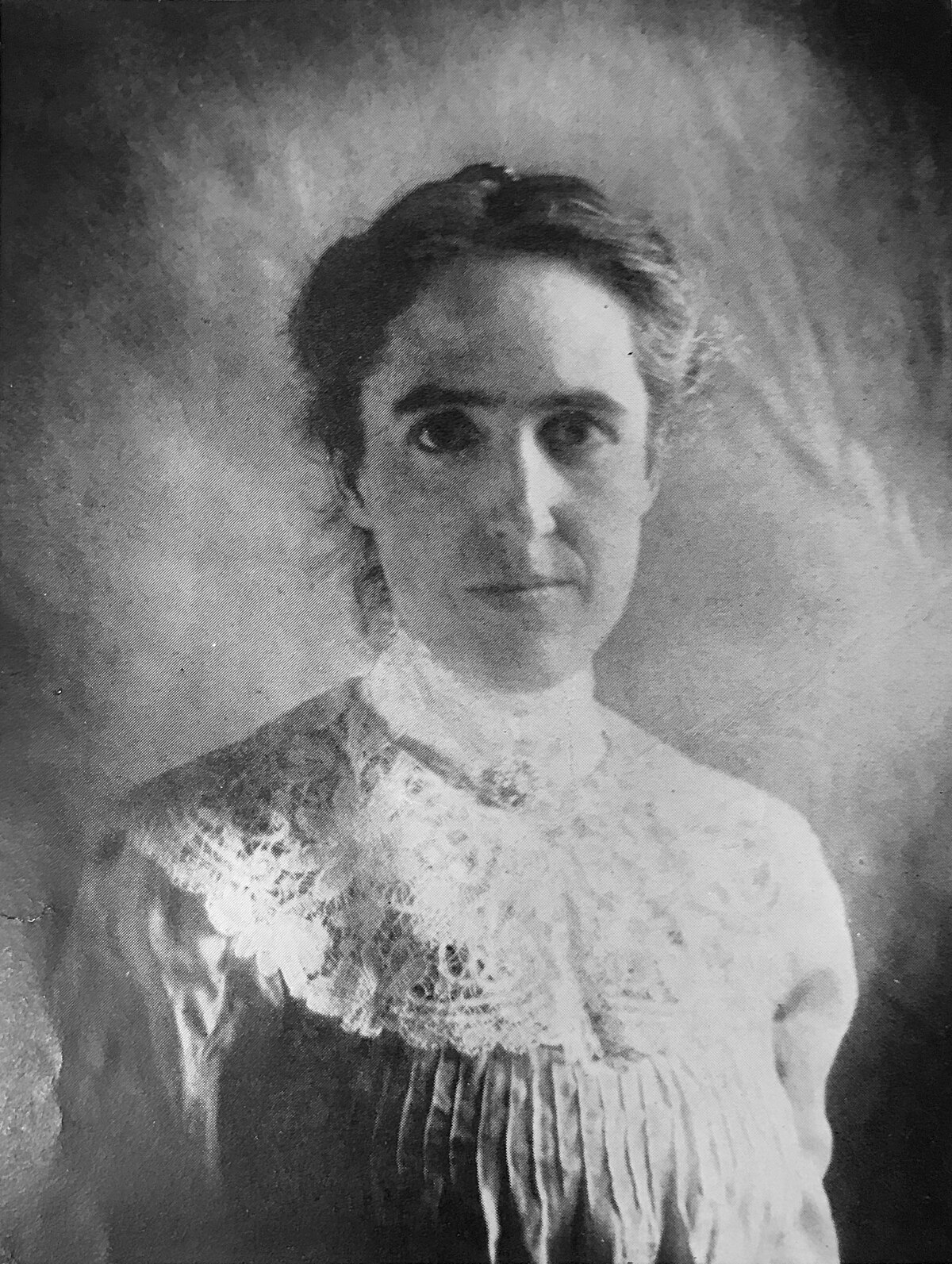 |
| Henrietta Swan Leavitt American astronomer, human computer and an unsung heroine of science Credit: LC Catalogue |
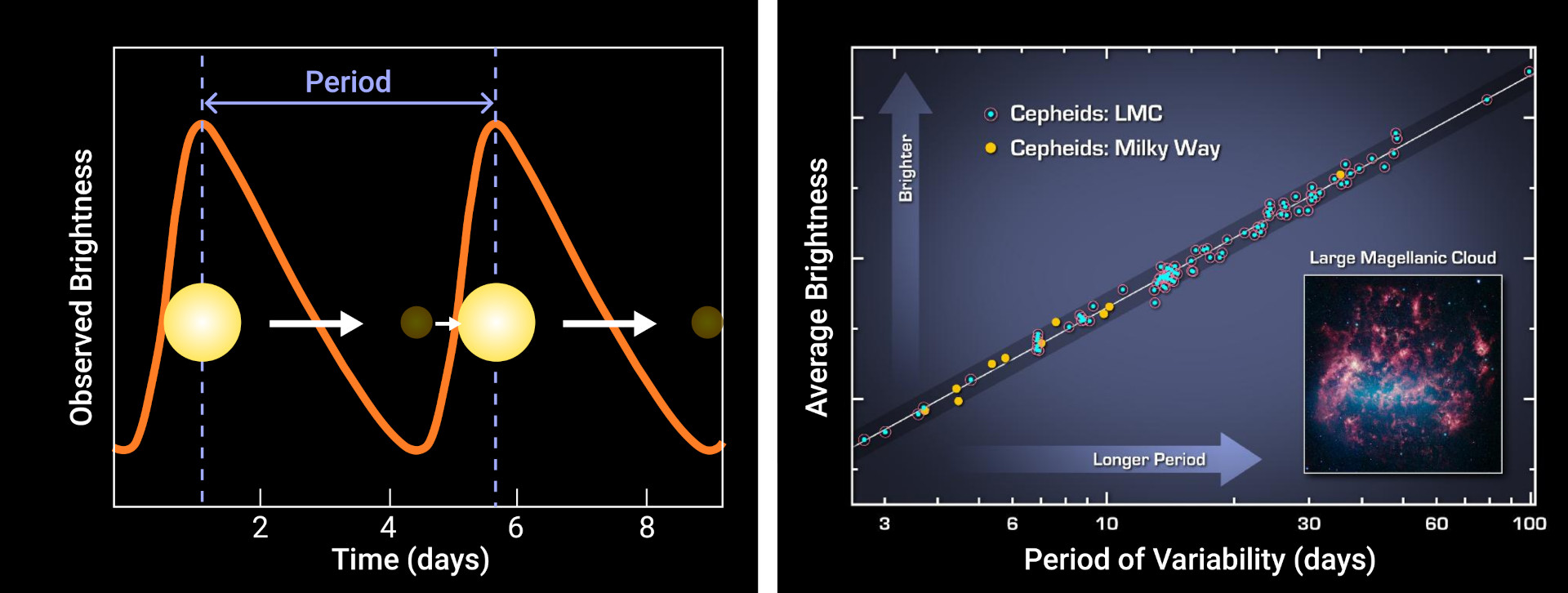 |
| The graph on the left depicts the relation between a Cepheid's brightness and its period, and the graph on the right depicts Leavitt's law. Credit: Structures Blog |
 |
| The formula for calculating the distance to a cepheid variable. Credit: Physics LibreTexts |
Hubble used these cepheid variable standard candles to deduce the distances to distant objects (such as the Andromeda galaxy, then known as the Andromeda nebula) by comparing the apparent luminosity of these cepheid variables, or their apparent magnitude to their true luminosity or absolute magnitude (calculable from the knowledge of their periods, as dictated by Leavitt’s law). He obtained a figure of 900,000 light years. We know today, with improved measurements that the figure is actually closer to 2.5 million light years, but even then, it put these Cepheid variables inside the Andromeda “nebula” well outside the range of the Milky Way galaxy. This led Harlow Shapley, a prominent proponent of the idea that the Milky Way galaxy constitutes the whole universe to remark,
“Here is the letter that destroyed my universe.”
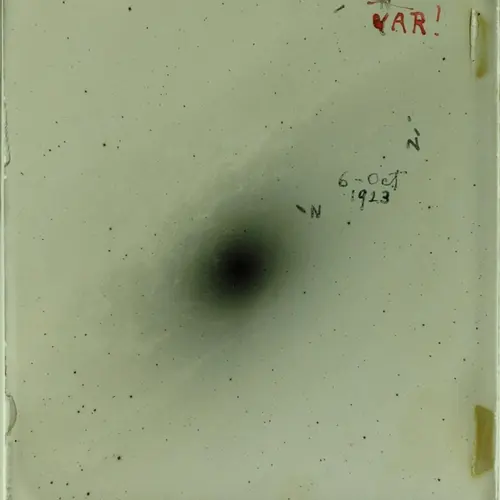 |
| Hubble's plate of Messier 31 (The Andromeda galaxy) with identification number H335H. The 'VAR' at the top right corner refers to a Cepheid variable. Credit: Lowell Observatory |
Hubble had shown the
universe was BIG. He didn’t just stop there, however. Next, he showed it was
growing BIGGER, i.e. the universe is expanding. And it wasn’t growing bigger at
a constant rate either—the rate of expansion of the universe was accelerating—something
that would be discovered not by Hubble himself, but by several teams of
sleuthing scientists around the world towards the end of the 20th century.
Hubble’s Law
 |
| Hubble's original data with linear fitting Credit: Lumen Learning |
Hubble didn’t just
estimate the distance to a few Cepheid variables in the Andromeda galaxy, he
used Cepheid variables and other standard candles to estimate the distances to
as many as 24 extra-galactic nebulae (or galaxies). Plotting the distances to these
galaxies against their recessional velocities obtained from their redshifts
(using data collated by Vesto Slipher), Hubble obtained a linear curve, which
later became known as Hubble’s law.
So, in summary, Hubble's law was derived from both the distance measurements to galaxies using cepheid variable stars within them, as well as the recessional velocities to these galaxies calculated using the redshift data. Both sets of methods allowed Hubble to deduce the law more accurately.
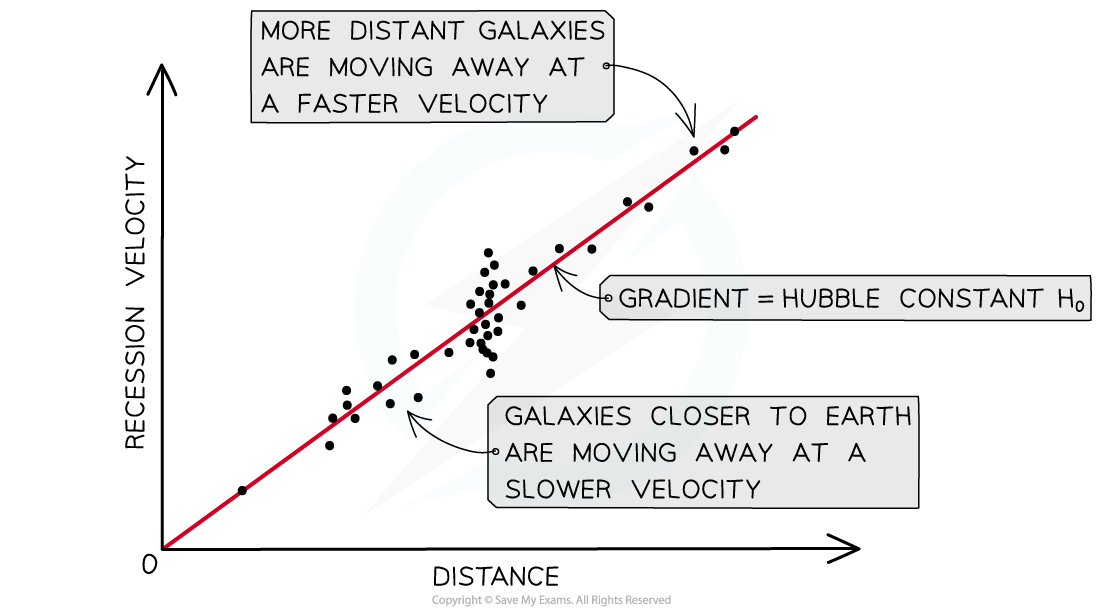 |
| Graphical representation of Hubble's law. The slope of the line is Hubble's constant- a quantity derived from the Hubble parameter Credit: Save My Exams |
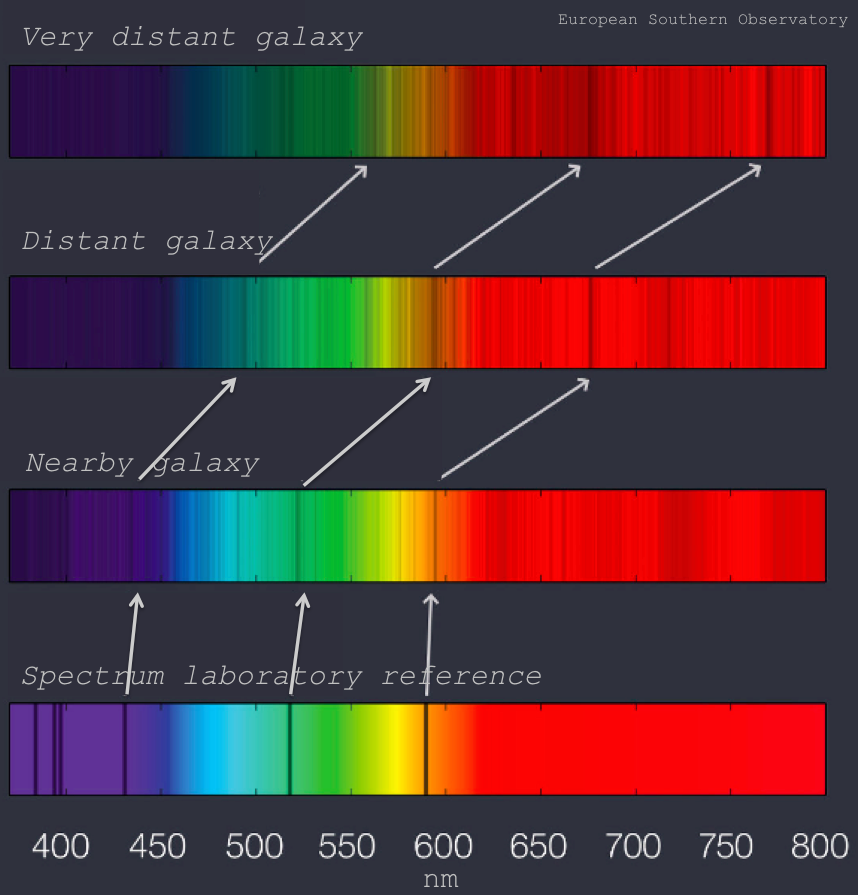 |
| Increasingly redshifted galaxy spectra Credit: The University of Iowa |
Note that the Hubble constant (denoted by H0) is a constant at any moment in time, and denotes the current rate of expansion of the universe. Its value is about 70 km/s Mpc. The Hubble parameter also gives the expansion rate but it varies with time.
Pause a moment to
consider what this means. Obtaining a linear relationship between distance and
radial velocity means that the further away a galaxy is, the faster it appears
to be moving away from us.
What does this suggest? From
our point of view (and indeed every other point of view in an isotropic
universe), the universe is expanding. Like a giant balloon with little sharpie
dots marked on it, the universe is “blowing up” with galaxies moving away from
each other faster the farther they are. An alternate analogy is of a bread with
little bits of fruit or raisin in it rising as it bakes. The raisins or bits of
fruit are pushed apart as the intervening dough expands.
Hubble had discovered that
the universe is a lot like that raisin-bread. It is expanding.
At the end of the 20th century,
we discovered that that expansion is accelerating.
 |
| The balloon analogy for the expanding universe Credit: Science Photo Library |
The Universe Started With
a Bang
The developments in
physics and cosmology up until this point formed the bedrock for what
eventually became the “Big Bang Hypothesis”. After all, a straight chain of
reasoning tells us that if the universe is expanding today, it must have been
smaller at some point in the past. If we advance the clock back far enough, one
can see how the idea that the universe started “in a hot, dense state” would
develop quite naturally. In fact, Georges Lemaître, a Belgian priest and
physicist, combing Einstein’s field equations describing a dynamic, homogeneous
and isotropic universe with Hubble’s observations proposed the "hypothesis
of the primeval atom", now regarded as the first formulation of the Big
Bang theory of the origin of the universe. The universe suddenly had a
beginning.
 |
| Belgian physicist and priest Georges Lemaître Credit: Brittanica |
 |
| The Big Bang wasn't so much an explosion in space, as an explosion of space. Credit: HubbleSite |

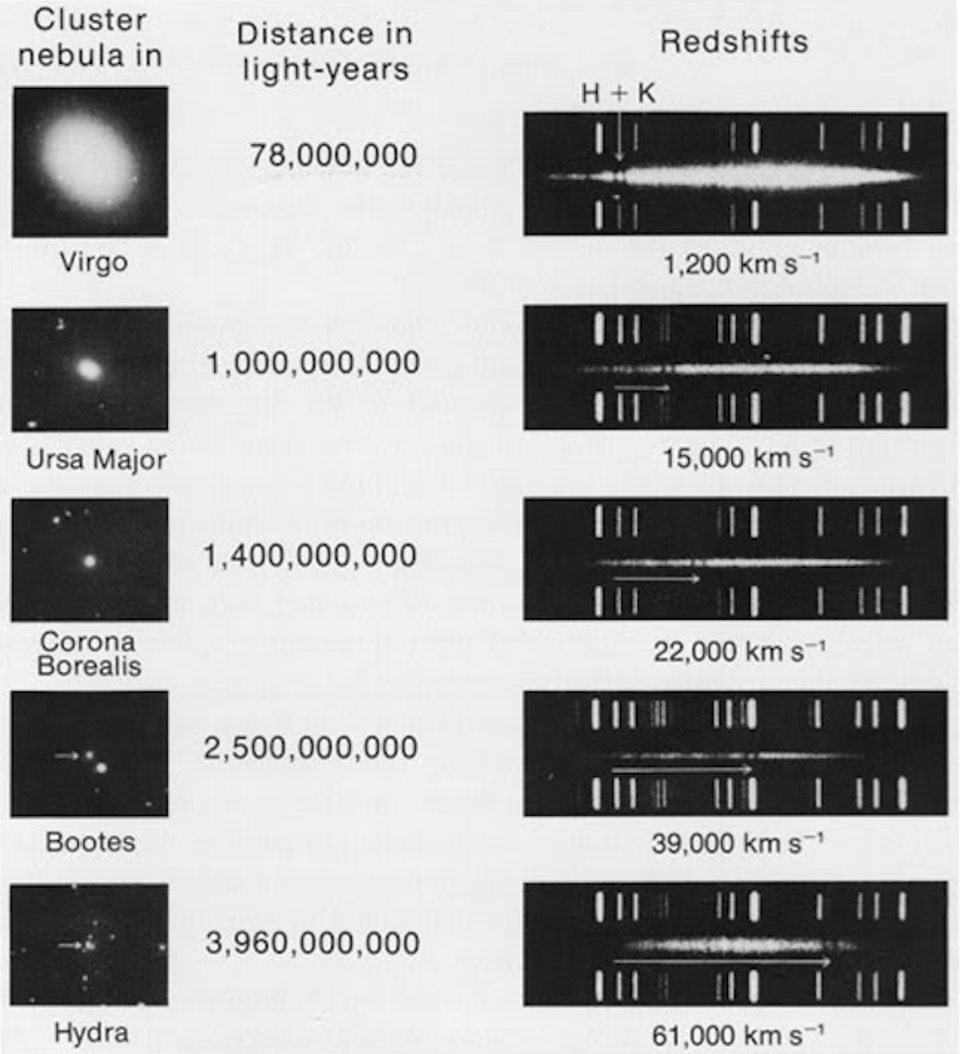

I had heard of these concepts. But reading this piece made me aware how much of it I had misunderstood.
ReplyDelete